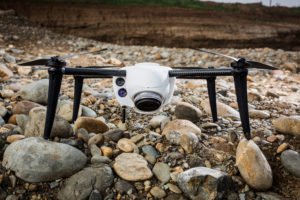Kespry has always been an enterprise-focused drone solution. The company realized early that ease of use was key to adoption: and they offered one of the first automated, no-joystick flight solutions. As the industry matures and automation becomes more available – and more sophisticated – we interviewed Kespry CEO George Mathew for his views on automation, enterprise scales, and what’s needed to take the industry forward in 2020.
Mathew says that automation has been a game changer for Kespry, and that it is only getting more important. “Automation was by far one of the key differentiators for Kespry – and I don’t think that’s changed, if anything it is accelerating,” says Mathew. “I think that this is the natural way that most scaled out operations are going to occur around the world. There aren’t enough pilots in the world to be able to manually process the data; but with automation and AI, it can work.”
As the industry moves into use cases like delivery, and regulations accomodate flight beyond visual line of sight (BVLOS) and, in future, multiple drones per pilot, Mathew sees the need for automated flight and data collection increasing further. “This is the new normal for the industry,” says Mathew, commenting that many new offerings on the recreational market now offer some sort of automation.
UTM and What’s Needed to Move the Industry Forward
When it comes to industry challenges, standardization is key, says Mathew. Remote ID and unmanned traffic management systems are critical to expanding automation use cases. “As far as UTM goes, it has been a long road – there have been good steps forward, but its obviously slow,” says Mathew. “I think long term, there is the need to have something related to ID as a standard set of protocols for the industry to grow. There are 277,000 commercial drone pilots – and you see use cases moving into the billion range – how do you do that without some kind of system that helps you interoperate?”
“Autonomy scale requires some level of standards and deconfliction.”
Kespry has been able to grow within the limits of regulations – but they’re looking beyond what’s currently allowed for future growth. “Our customers have Part 107 licenses in place and we’re operating within very geo-fenced parameters, on industrial sites,” Mathew says. “But think about the areas that we haven’t been able to tackle – flying beyond visual line of sight, flying over a hill on a large site to see what’s going on – that’s where you’re going to see more use cases, extended use cases where you don’t necessarily need a visual observer,” he comments.
Expanding Up to the Enterprise, Down to the Consumer, or Both
While Kespry has been an enterprise solution from the beginning, Mathew offers an interesting perspective on opportunities for growth in the industry. “For Kespry, we decided to go enterprise,” says Mathew. “But with the partnership with XAP, we have a channel that gives us the leverage to get into smaller roofing companies, smaller businesses. For us, it will continue to be an enterprise focus: but where we can find an enterprise channel, we want to do that.”
“The expansion of the overall market, though, isn’t going to be all about the enterprise – it’s going to be going both directions,” Mathew says, using roofing as an example. “There are two sides of a transaction when it comes to storm damage: one side of that transaction is the claims process, the flip side is that roofers have to get involved to actually fix the roof. Our customers decided that we were good neutral arbiters – a single, reliable data set.”
Outside of the question of enterprise or consumer focus, however, Mathew says that identifying the need, wherever it is, is the point. “Where we continue to focus is about the transformation of work – where physical assets need to be measured and evaluated, we can provide sharp focus for the industry,” says Mathew. “The good news right now is that there are viable business models in the drone sector…we have over 300 customers, 5500 missions around industrial worksites. There is plenty of opportunity to find scale in our business.”
Miriam McNabb is the Editor-in-Chief of DRONELIFE and CEO of JobForDrones, a professional drone services marketplace, and a fascinated observer of the emerging drone industry and the regulatory environment for drones. Miriam has a degree from the University of Chicago and over 20 years of experience in high tech sales and marketing for new technologies.
Email Miriam
TWITTER:@spaldingbarker
Subscribe to DroneLife here.
https://dronelife.com/2019/12/20/kesprys-george-mathew-on-automation-enterprise-scale-and-whats-next-for-the-drone-industry/
 Unmanned Aerial Vehicle The latest drone news
Unmanned Aerial Vehicle The latest drone news



